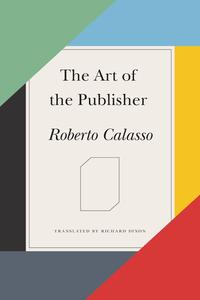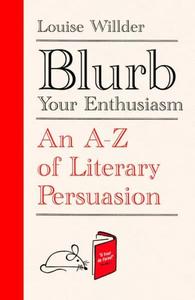 The cover flap is a humble and arduous literary form.... For a publisher, it is often the only opportunity to spell out what spurred him to choose a particular book. For the reader, it is a text to be read with caution, for fear of it being a piece of surreptitious hype. And yet the cover flap is part of the book, of its physiognomy, like the color and picture on the front cover, like the typeface in which it is printed. And a literary civilization can be recognized by the way its books are presented.
The cover flap is a humble and arduous literary form.... For a publisher, it is often the only opportunity to spell out what spurred him to choose a particular book. For the reader, it is a text to be read with caution, for fear of it being a piece of surreptitious hype. And yet the cover flap is part of the book, of its physiognomy, like the color and picture on the front cover, like the typeface in which it is printed. And a literary civilization can be recognized by the way its books are presented.
Book blurbs have been in the news recently, and not in a good way. I don't love blurbs, but I understand their necessary place in the book trade. When I was a bookseller, I used them sometimes to convince readers to buy a book. As a reader, I've occasionally (if rarely) let a blurb tip me over the line into buying a book. I've even written a few blurbs.
That doesn't mean I always trust them. I don't think of myself as a conspiracy theorist, but (the inevitable "but" of conspiracy theorists) I've been in the business long enough to recognize the six (or fewer) degrees of separation between authors and some of their blurbers.
 "The practice of 'blurbing' has a fairly ignoble reputation, seeming to many like an endless merry-go-round of hype, mutual back-slapping and back-scratching; the worst kind of literary cronyism," longtime copywriter Louise Willder wrote in her book Blurb Your Enthusiasm.
"The practice of 'blurbing' has a fairly ignoble reputation, seeming to many like an endless merry-go-round of hype, mutual back-slapping and back-scratching; the worst kind of literary cronyism," longtime copywriter Louise Willder wrote in her book Blurb Your Enthusiasm.
A recent dustup about extracting positive blurbs from negative reviews dragged another familiar, if always unsettling, aspect of blurbing from the shadows into the light again.
In mid-August, media reports appeared regarding some blurbs used on the U.K. edition of Jordan Peterson's Beyond Order: 12 More Rules for Life, which had "drawn criticism for splicing negative quotes from reviewers to suggest positive endorsements for the book," the Bookseller reported. Several journalists from major newspapers, including Sunday Times literary editor Johanna Thomas-Corr, had spoken out about the situation while other commentators believed the wider industry practice needed to be examined.
Thomas-Corr, who discovered that parts of her review of Peterson's book for the New Statesman were misused on the book's cover, wrote in the Sunday Times: "You can imagine my surprise, then, when I learnt via social media of a controversy... whereby damning reviews had somehow become lavish praise.... Of course, most people in publishing are aware of the industry's log-rolling practices, but many feel a line has been irreversibly crossed... I suspect the industry will have to review its practices."
While acknowledging in Blurb Your Enthusiasm that, as a copywriter, she was capable of "filleting reviews" for jacket copy, Willder also noted there was a line she wouldn't cross: "Breaking up and reordering the words from a review is common practice, but pretending a bad review is good is beyond the pale."
A BBC News report on the Peterson incident echoed the hope that this could lead to a wider debate on the subject of blurbs: "Although it is normal for publishers to use techniques to increase sales, the complaints could raise questions in the publishing industry about selective quoting."
A couple of weeks after the initial furor, the Bookseller followed up with a piece reporting that the Society of Authors had denounced the industry's "morally questionable" use of "puff" on book jackets.
"Quoting lines out of context isn't clever marketing, readers deserve to know what they are buying and reviewers deserve the confidence that their comments will be honestly represented," said Nicola Solomon, CEO of the SoA. "Everyone understands that there will be some 'puff' but this goes far beyond that and there should be no place for it in an industry built on the exchange of creativity, knowledge and ideas.... Readers and authors deserve honest, fair marketing from publishers. We can't get that by undermining and misrepresenting one writer to boost the sales of another."
In the wake of the controversy, a spokesperson for Bonnier Books UK (which isn't Jordan Peterson's publisher) told the Bookseller it is planning a best practice guide for future use: "Our teams apply common sense and respect in terms of the use of these blurbs. We appreciate the time and level of engagement that goes into every write-up, and any shortened quotes should always reflect the tone and intention of the original review."
In The Art of the Publisher ("Highly recommended!!!"--me), Roberto Calasso observed of the cover flap copy for his press, Adelphi Edizioni:
From the very beginning, they obeyed one single rule: that we ourselves could take them at face value; and one single desire: that our readers, contrary to custom, could do the same. In that cramped rhetorical space, less fascinating than that of a sonnet but equally exacting, there was room for just a few effectual words, like when you introduce one friend to another and you must overcome the slight embarrassment that always exists in every introduction, above all between friends, as much as respecting the rules of good manners that prevent you from emphasizing the defects of the friend being introduced. But there was, in all this, also an element of constraint: it is well known that the art of sound praise is no less difficult than that of scathing criticism.
Sounds like the perfect epigraph for a book blurb best practice guide.
--Robert Gray, contributing editor

